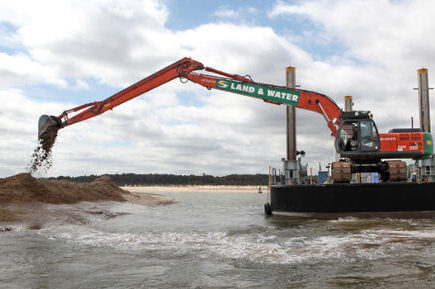
The global sand extraction industry is under the spotlight as concerns grow over its impact on marine life, coastal communities facing sea level rise, and ecosystems. The first-ever global data platform, developed by the United Nations Environment Programme (UNEP), is revealing the alarming scale of sand extraction from the world’s oceans.
This platform, called Marine Sand Watch, utilizes Automatic Identification System (AIS) data from ships to track and monitor sand dredging in marine environments.
According to data spanning from 2012 to 2019, the platform estimates that the dredging industry extracts a staggering 6 billion tonnes of marine sand annually. This rate of extraction is described as “alarming” and is approaching the natural replenishment rate, which should be 10 to 16 billion tonnes per year, necessary to maintain coastal structures and ecosystems. The relentless extraction of sand poses a significant threat to the environment and coastal areas.
Several key “hotspots” have been identified, including the North Sea, southeast Asia, and the east coast of the United States. In some regions, particularly parts of Asia, the extraction of marine sand far surpasses the rate at which it is naturally replenished by rivers.
“The scale of environmental impacts of shallow sea mining activities and dredging is alarming, including biodiversity, water turbidity, and noise impacts on marine mammals,” said Pascal Peduzzi, the director of GRID-Geneva at Unep.
“This data signals the urgent need for better management of marine sand resources and to reduce the impacts of shallow sea mining,” he said. “Unep invites all stakeholders, member states and the dredging sector to consider sand as a strategic material, and to swiftly engage in talks on how to improve dredging standards around the world.”
The platform, developed by GRID-Geneva, a UNEP centre for analytics, employs artificial intelligence to track the movements of dredging vessels using AIS data. While the available data ranges from 2012 to 2019, the platform aims to collect more recent data.
Sand and gravel account for half of all the materials mined globally. Approximately 50 billion tonnes of sand and gravel are consumed each year, equivalent to a wall 27 meters high and 27 meters wide encircling the equator. Sand is a crucial component in the production of concrete and asphalt, making it a fundamental resource for construction.
“Our entire society is built on sand, the floor of your building is probably concrete, the glass on the windows, the asphalt on roads is made of sand,” said Peduzzi. “We can’t stop doing it because we need lots of concrete for the green transition, for wind turbines and other things.”
UNEP has previously called for improved monitoring of sand extraction to avert an environmental crisis. They recommended a halt to beach mining and the establishment of international standards for marine sand extraction. While land-based sand extraction can sometimes be restored, removing sand and other materials from marine and river environments leads to alterations in river and coastline shapes and causes damage to the sea floor.
“These vessels are like a giant vacuum cleaner on the bottom of the sea,” he said. “All the micro-organisms in the sand are crunched and nothing is left behind. If you take all the sand away to bare rock, nothing will recover. But if you leave 30-50cm it will recover.”
The International Association of Dredging Companies (IADC), the industry’s umbrella organisation, recently published guidelines for responsible dredging practices in response to concerns about the “scarce resource.” The aggregate industry, including sand and gravel extraction, is valued at hundreds of billions of dollars annually.
While international practices and regulations differ, some countries, such as Indonesia, Thailand, Malaysia, Vietnam, and Cambodia, have banned the export of marine sand. The initiative by UNEP/GRID-Geneva aligns with a resolution from the UN Environment Assembly to enhance knowledge and promote global policies and actions for sustainable sand extraction and use.
China, which operates 200 dredging vessels, is reportedly developing an even more powerful dredger, potentially 50% more potent than its existing “super island builder in the South China Sea.” These developments underscore the urgency of addressing the environmental consequences of sand extraction and the need for responsible and sustainable practices in the industry.
——————————————————————————
At Natural World Fund, we are passionate about stopping the decline in our wildlife.
The decline in our wildlife is shocking and frightening. Without much more support, many of the animals we know and love will continue in their decline towards extinction.
When you help to restore a patch of degraded land through rewilding to forests, meadows, or wetlands, you have a massive impact on the biodiversity at a local level. You give animals a home and food that they otherwise would not have had, and it has a positive snowball effect on the food chain.
We are convinced that this is much better for the UK than growing lots of fast-growing coniferous trees, solely to remove carbon, that don’t actually help our animals to thrive.
This is why we stand for restoring nature in the UK through responsible rewilding. For us, it is the right thing to do. Let’s do what’s right for nature!
Donate today at https://naturalworldfund.com/ and join in the solution!

